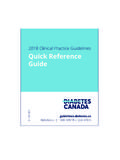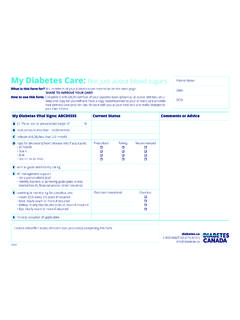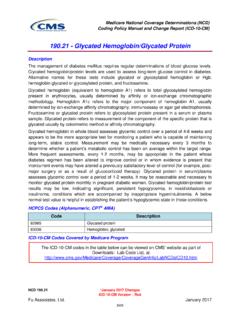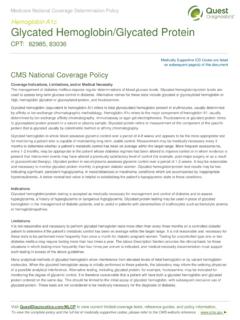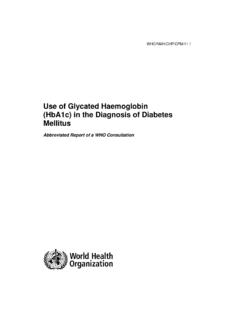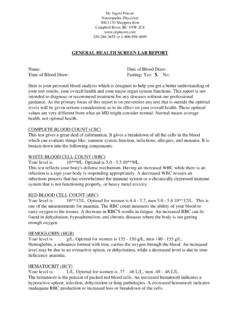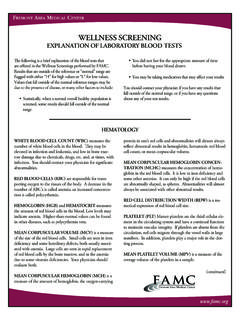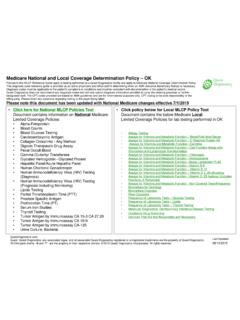Transcription of Canadian Journal of Diabetes
1 Can J Diabetes 42 (2018) S283 S295. Contents lists available at ScienceDirect Canadian Journal of Diabetes Journal homepage: w w w. c a n a d i a n j o u r n a l o f d i a b e t e s . c o m 2018 Clinical Practice Guidelines Diabetes in Older People Diabetes Canada Clinical Practice Guidelines Expert Committee Graydon S. Meneilly MD, FRCPC, MACP, Aileen Knip RN, MN, CDE, David B. Miller MD, FRCPC, Diana Sherifali RN, PhD, CDE, Daniel Tessier MD, MSc, FRCPC, Afshan Zahedi BASc, MD, FRCPC. sometime around age 70 and is characterized by a slow, progressive KEY MESSAGES impairment in function that continues until the end of life (1). There are many people with type 2 Diabetes who are over the age of 70. Diabetes in older people is distinct from Diabetes in younger people and who are otherwise well, functionally independent/not frail and have the approach to therapy should be different. This is especially true in those at least a decade of healthy life expectancy.
2 These people should who have functional dependence, frailty, dementia or who are at end of life. This chapter focuses on these individuals. Personalized strategies are be treated to targets and with therapies described elsewhere in this needed to avoid overtreatment of the frail elderly. guideline (see Targets for Glycemic Control chapter, p. S42 and Phar- In the older person with Diabetes and multiple comorbidities and/or frailty, macologic Glycemic Management of Type 2 Diabetes in Adults strategies should be used to strictly prevent hypoglycemia, which include chapter, p. S88). This chapter focuses on older people who do not the choice of antihyperglycemic therapy and a less stringent glycated hemo- globin (A1C) target. fall into any or all of those categories. Decisions regarding therapy Sulphonylureas should be used with caution because the risk of hypogly- should be made on the basis of age/life expectancy and the person's cemia increases signi cantly with age.
3 Functional status. Where possible, evidence is based on studies where DPP-4 inhibitors should be used over sulfonylureas because of a lower risk either the main focus was people over the age of 70 years or where of hypoglycemia. a substantial subgroup, speci cally reported, were in this age group. Long-acting basal analogues are associated with a lower frequency of hypo- glycemia than intermediate-acting or premixed insulin in this age group. Diagnosis and Screening KEY MESSAGES FOR OLDER PEOPLE WITH Diabetes As noted in the De nition, Classi cation and Diagnosis of Dia- betes, Prediabetes and Metabolic Syndrome chapter, p. S10, glycated No two older people are alike and every older person with Diabetes needs hemoglobin (A1C) can be used as a diagnostic test for type 2 dia- a customized Diabetes care plan. What works for 1 individual may not be betes in adults. Unfortunately, normal aging is associated with a pro- the best course of treatment for another.
4 Some older people are healthy and can manage their Diabetes on their own, while others may have 1 or gressive increase in A1C, and there can be a signi cant discordance more Diabetes complications. Others may be frail, have memory loss and/or between glucose-based and A1C-based diagnosis of Diabetes in this have several chronic diseases in addition to Diabetes . age group, a difference that is accentuated by race and gender (2). Based on the factors mentioned above, your Diabetes health-care team will (see Monitoring Glycemic Control chapter, p. S47). Pending further work with you and your caregivers to select target blood glucose and studies to de ne the role of A1C in the diagnosis of Diabetes in the glycated hemoglobin (A1C) levels, appropriate glucose-lowering medica- tions, and a program for screening and management of Diabetes -related elderly, other tests may need to be considered in some older people, complications. especially where the elevation in A1C is modest ( to ).
5 Because they are complementary, we recommend screening with both a fasting plasma glucose and an A1C in older people. Screening for Diabetes may be warranted in select individuals. Introduction In the absence of positive intervention studies on morbidity or mor- tality in this population, the decision about screening for Diabetes This guideline refers primarily to type 2 Diabetes in the older should be made on an individual basis. Screening is unlikely to be person. There is limited information on the management of type 1 bene cial in most people over the age of 80. Diabetes in the elderly, but this is included wherever appropriate. The de nition of older varies, with some studies de ning the elderly population as 60 years of age. Administrative guidelines Reducing the Risk of Developing Diabetes frequently classify people >65 years of age as older. Although there is no uniformly agreed-upon de nition of older, it is generally Healthy behaviour interventions are effective in reducing the risk accepted that this is a concept that re ects an age continuum starting of developing Diabetes in older people at high risk for the devel- opment of the disease (3).
6 Acarbose (4), rosiglitazone (5) and Con ict of interest statements can be found on page S290. pioglitazone (1,6) also are effective in preventing Diabetes in high-risk 1499-2671 2018 Canadian Diabetes Association. The Canadian Diabetes Association is the registered owner of the name Diabetes Canada. S284 Meneilly et al. / Can J Diabetes 42 (2018) S283 S295. elderly. Metformin may not be effective (3). Since several of these circumference in older adults ranging from 65 to 76 years of age drugs have signi cant toxicity in the older adult (see below) and (26). Diabetes self-management programs with access to geriatric since there is no evidence that preventing Diabetes will make a dif- teams ( geriatricians, Diabetes nurse educators, registered dieti- ference in outcomes in these people, there would appear to be little tians) can further improve glycemic control and self-care behaviours justi cation for drug therapy to prevent Diabetes in older adults.
7 When compared to usual care, by assessing barriers and providing strategies and opportunities for ongoing support between clinic visits (27). Management Targets for glycemic control Organization of care The same glycemic targets apply to otherwise healthy older adults As interprofessional interventions speci cally designed for older as to younger people with Diabetes (see below), especially if these adults have been shown to improve glycemic control, referrals to targets can be obtained using antihyperglycemic agents associ- Diabetes health-care (DHC) teams should be facilitated (7 9). Pay- ated with low risk of hypoglycemia (see Targets for Glycemic Control for-performance programs improve a number of quality indica- chapter, p. S42). In older people with Diabetes of several years' dura- tors in this age group (10,11). Telemedicine case management and tion and established complications, intensive control reduced the web-based interventions can improve glycemic control, lipids, blood risk of microvascular events but did not reduce cardiovascular (CV).
8 Pressure (BP), psychosocial well-being and physical activity; reduce events or overall mortality (28 31). Overall mortality was increased hypoglycemia and ethnic disparities in care; and allow for detec- in the Action to Control Cardiovascular Risk in Diabetes (ACCORD). tion and remediation of medically urgent situations, as well as reduce study. Therefore, in older people with longstanding Diabetes and hospitalizations (12 21). A pharmaceutical care program ( moni- multiple comorbidities, intensive glycemic control is not advis- toring of symptoms, medication counselling, facilitating commu- able. While the initial report of the ACCORD-MIND substudy sug- nications with physicians/nurse practitioners by pharmacists) can gested that intensive control preserved brain volume but did not signi cantly improve medication compliance, as well as the control alter cognitive outcomes, subsequent follow up found no impact of Diabetes and its associated risk factors (22,23) (see Organiza- on either parameter (32).)
9 However, better glycemic control may be tion of Care chapter, ). associated with less disability and better function (33,34). In cohort studies, it has been demonstrated that the best survival is present Self-management education and support in elderly people with an A1C between to , and values above and below this range are associated with increased mortality (35,36). Self-management education and support programs are a vital Table 1 outlines glycemic targets for the elderly across the health aspect of Diabetes care, particularly for older adults who may require spectrum. additional education and support in light of other chronic condi- Recently, an A1C-derived average blood glucose value has been tions and polypharmacy (24). Recently, a population-based cohort developed and offered to people with Diabetes and health-care pro- study of older adults ( 65 years of age) living in Ontario found that viders as a better way to understand glycemic control.
10 While this attendance at a Diabetes education program was associated with is a valuable parameter in younger people, this variable and A1C. better quality of care, and better participation relating to educa- may not accurately re ect continuous glucose monitoring (CGM). tion utilization and retinopathy screening (25). A review of diabe- measured glucose values or glycemic variability in the older adult tes self-management programs for older adults 65 years of age, (37). identi ed that programs that emphasized tailored education and It has been suggested that postprandial glucose values are a better support, or psychological support resulted in greater reductions in predictor of outcome in older people with Diabetes than A1C or A1C, when compared to group-setting education, review and feed- preprandial glucose values. Older people with type 2 Diabetes who back monitoring, or medical management (24) (see Self-Management have survived an acute myocardial infarct (MI) may have a lower Education and Support chapter, p.)
